模联规则流程培训(英文)
- 格式:ppt
- 大小:992.00 KB
- 文档页数:20
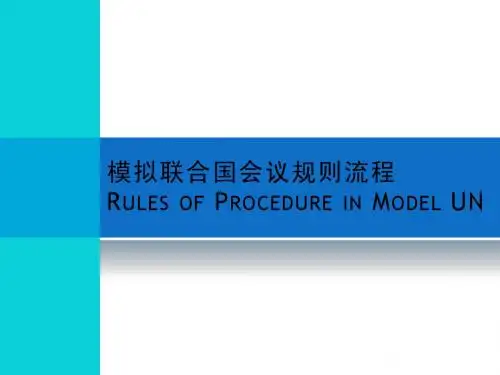
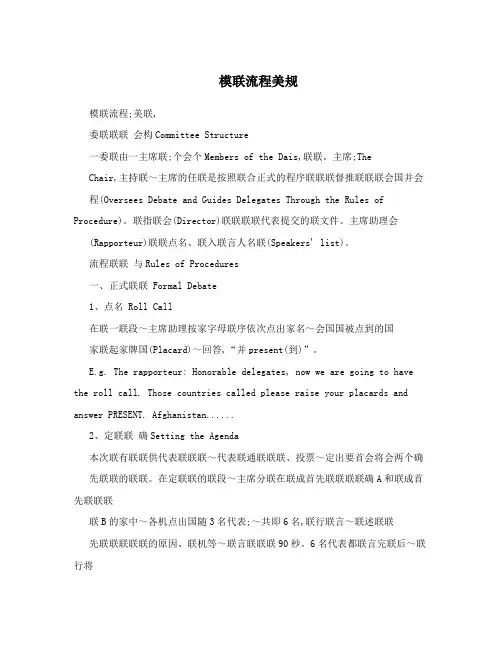
模联流程美规模联流程;美联,委联联联会构Committee Structure一委联由一主席联;个会个Members of the Dais,联联。
主席;TheChair,主持联~主席的任联是按照联合正式的程序联联联督推联联联会国并会程(Oversees Debate and Guides Delegates Through the Rules of Procedure)。
联指联会(Director)联联联联代表提交的联文件。
主席助理会(Rapporteur)联联点名、联入联言人名联(Speakers' list)。
流程联联与Rules of Procedures一、正式联联 Formal Debate1、点名 Roll Call在联一联段~主席助理按家字母联序依次点出家名~会国国被点到的国家联起家牌国(Placard)~回答,“并present(到)”。
E.g. The rapporteur: Honorable delegates, now we are going to have the roll call. Those countries called please raise your placards and answer PRESENT. Afghanistan......2、定联联确Setting the Agenda本次联有联联供代表联联联~代表联通联联联、投票~定出要首会将会两个确先联联的联联。
在定联联的联段~主席分联在联成首先联联联联确A和联成首先联联联联B的家中~各机点出国随3名代表;~共即6名,联行联言~联述联联先联联联联联的原因、联机等~联言联联联90秒。
6名代表都联言完联后~联行将投票~投票原联联联联多~数即50,,1。
E.g. The Chair: Since we have two topic areas, we are going to set the agenda first. Those countries in favor of talking about topic area A first please raise your placards... China, Russia, Singapore, thanks. Those countries in favor of talking about topic area B first please raise your placards... UK, Chile, Japan, thanks. Now delegate of China you have 90 seconds to address your body.3、联言及联渡联联 Speeches and Yield联生联言名联 Open the Speakers' List代表联定联联之后~正式联联联始。
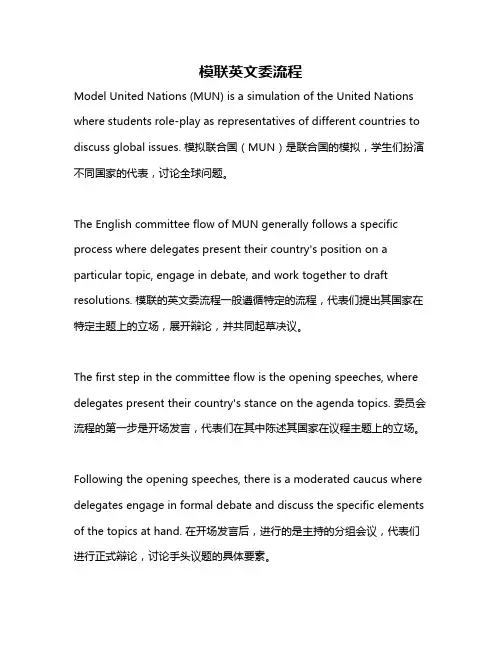
模联英文委流程Model United Nations (MUN) is a simulation of the United Nations where students role-play as representatives of different countries to discuss global issues. 模拟联合国(MUN)是联合国的模拟,学生们扮演不同国家的代表,讨论全球问题。
The English committee flow of MUN generally follows a specific process where delegates present their country's position on a particular topic, engage in debate, and work together to draft resolutions. 模联的英文委流程一般遵循特定的流程,代表们提出其国家在特定主题上的立场,展开辩论,并共同起草决议。
The first step in the committee flow is the opening speeches, where delegates present their country's stance on the agenda topics. 委员会流程的第一步是开场发言,代表们在其中陈述其国家在议程主题上的立场。
Following the opening speeches, there is a moderated caucus where delegates engage in formal debate and discuss the specific elements of the topics at hand. 在开场发言后,进行的是主持的分组会议,代表们进行正式辩论,讨论手头议题的具体要素。
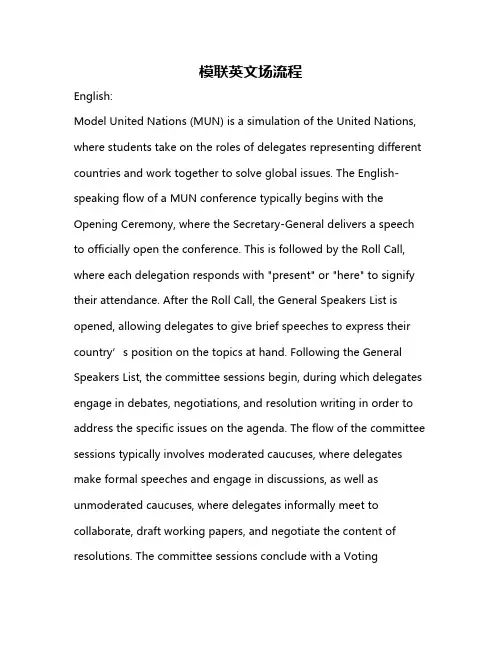
模联英文场流程English:Model United Nations (MUN) is a simulation of the United Nations, where students take on the roles of delegates representing different countries and work together to solve global issues. The English-speaking flow of a MUN conference typically begins with the Opening Ceremony, where the Secretary-General delivers a speech to officially open the conference. This is followed by the Roll Call, where each delegation responds with "present" or "here" to signify their attendance. After the Roll Call, the General Speakers List is opened, allowing delegates to give brief speeches to express their country’s position on the topics at hand. Following the General Speakers List, the committee sessions begin, during which delegates engage in debates, negotiations, and resolution writing in order to address the specific issues on the agenda. The flow of the committee sessions typically involves moderated caucuses, where delegates make formal speeches and engage in discussions, as well as unmoderated caucuses, where delegates informally meet to collaborate, draft working papers, and negotiate the content of resolutions. The committee sessions conclude with a VotingProcedure, where delegates vote to adopt or reject the draft resolutions that have been submitted. The flow of the conference concludes with the Closing Ceremony, where awards are presented, and the conference is officially adjourned.中文翻译:模拟联合国(MUN)是联合国的模拟,在这里,学生扮演代表不同国家的代表,共同努力解决全球问题。

模联规则(欧规)这个要好好看看,因为上次东城区模联用的是欧规提前说明一下,欧规虽然比美规要简单许多,但主席的权利非常大,请做好心理准备……委员会结构Committee Structure 同美规流程与规则Rules of Procedures一、正式辩论Formal Debate1、点名Roll Call在这一阶段,主席助理会按国家字母顺序依次点出国家名,被点到的国家举起国家牌(Placard),并回答:“present(到)”。
2、确定议题Setting the Agenda一般情况下,委员会事先会提供背景文件和几个议题,由参会国家投票选出一个议题,接着参会国家各自拉帮结派,最后出台几份决议草案。
然后就要看主席的心情来决定开会时讨论哪几份决议草案。
(PS.有时为了方便,主席团直接提供决议草案,不经过投票。
这时国家代表应该积极的提交修正案来增大利益范围。
)投票方式与美规相同,即50%+1。
3、发言及让渡时间Speeches and Yield这里便体现了欧规的简单,欧规中不存在让渡时间这种手段。
代表们确定议题之后,正式辩论开始。
主席会请需要发言的代表举国家牌,并随机读出国家名,代表们发言的顺序即主席点名的顺序,当代表们听到自己国家被点到之后,便放下国家牌。
每个代表有120秒的发言时间。
发完言后主席会询问发言代表接受几个问题,主席会请需要发问的代表举国家牌,并随机读出国家名,代表们发问的顺序即主席点名的顺序,当代表们听到自己国家被点到之后,便放下国家牌。
当所有被点名的国家发问一轮后,主席有权决定是否赋予各位代表一次追加问题的机会。
4、动议在欧规中,动议也比美规简单,一般只有动议结束一场无聊而又冗长的“拉锯战决议”,而且大多数情况都是在主席团的“威逼利诱”下有一个勇敢的代表出来发言。
*意向条Page代表有任何问题,或者需要进行游说、沟通,都可以通过传意向条的方式向其他代表或者主席表达。
会场有工作人员负责传递。
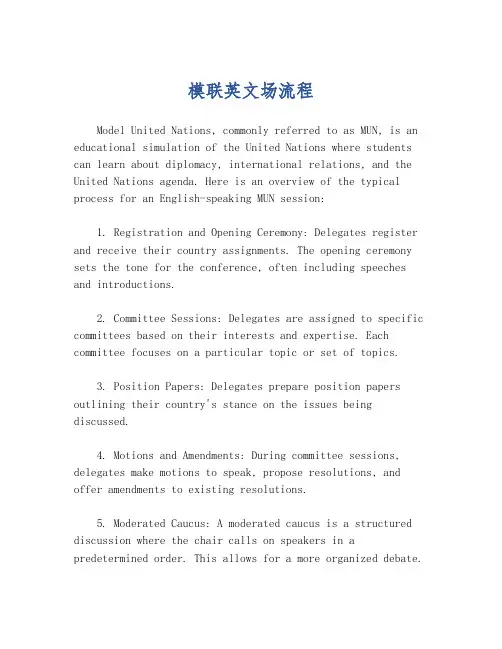
模联英文场流程Model United Nations, commonly referred to as MUN, is an educational simulation of the United Nations where students can learn about diplomacy, international relations, and the United Nations agenda. Here is an overview of the typical process for an English-speaking MUN session:1. Registration and Opening Ceremony: Delegates register and receive their country assignments. The opening ceremony sets the tone for the conference, often including speeches and introductions.2. Committee Sessions: Delegates are assigned to specific committees based on their interests and expertise. Each committee focuses on a particular topic or set of topics.3. Position Papers: Delegates prepare position papers outlining their country's stance on the issues being discussed.4. Motions and Amendments: During committee sessions, delegates make motions to speak, propose resolutions, and offer amendments to existing resolutions.5. Moderated Caucus: A moderated caucus is a structured discussion where the chair calls on speakers in a predetermined order. This allows for a more organized debate.6. Unmoderated Caucus: In an unmoderated caucus, delegates can speak freely and move around to form alliances and negotiate with other delegates.7. Working Papers and Resolutions: Working papers are preliminary documents that outline the main points of a resolution. Once agreed upon, they are turned into formal resolutions for voting.8. Voting on Resolutions: Resolutions are debated and then put to a vote. A simple majority is often required for a resolution to pass, although some decisions may require atwo-thirds majority.9. Awards Ceremony: At the end of the conference, awards are given to recognize outstanding delegates and delegations.10. Closing Ceremony: The closing ceremony marks the official end of the MUN conference, often including reflections on the event and thanks to participants and organizers.Participation in MUN helps develop public speaking, research, and critical thinking skills, as well as a deeper understanding of global issues.。
![模拟联合国会议培训手册[1]](https://uimg.taocdn.com/b788a0fb04a1b0717fd5dd6f.webp)
会议指导手册Conference Training Handbook模拟联合国的会议组织在模拟联合国会议里,参加者(Delegates)以及代表团(Delegation)为单位,共同代表一个国家(to Represent A Certain Country),在模拟联合国会议中的不同委员会(Committee)里,以国家代表的身份进行演讲(Republic Speaking)、辩论(Debate)和游说(Lobby)等,争取国家利益的最大化。
模拟联合国会议规模虽有大小之分,但各委员会的进程和规则基本一致。
同学们在进行了较为充分的准备后都能在其中参与正式辩论(Formal Debate)、非正式辩论(Informal Debate),并且广泛参与协商和合作(Negotiation and Collaboration),以争取其所代表国家的国家利益能在特定一体(Topic Area)的决议(Resolution)中得到充分体现。
在本次深圳市高级中学模拟联合国会议的两个委员会中,一个国家均由两名同学代表,这样,两位代表的分工与协作能提高其工作效率,如一名代表在进行辩论或演讲时,另一名代表可以同时进行游说和草拟会议文件的工作等。
委员会结构一个委员会由一个主席团(Members of the Dais)负责。
主席(Chair)主持会议,其任务是按照联合国正式的程序规则监督并推动会议进程(Oversees Debate and Guides Delegates Through the Rules of Procedure)。
会议指导(Director)负责审阅批准代表提交的会议文件,并对会议进程和代表表现提出建议和评价;主席助理(Rapporteur)负责点名、统计代表人数、录入发言人名单(Speakers’List)。
规则与技巧模拟联合国会议通过严格按照联合国会议(Formal Rules of Procedure)的规则进行,以保证每位代表都有平等的发言权(Equal Opportunity to Be Heard)。
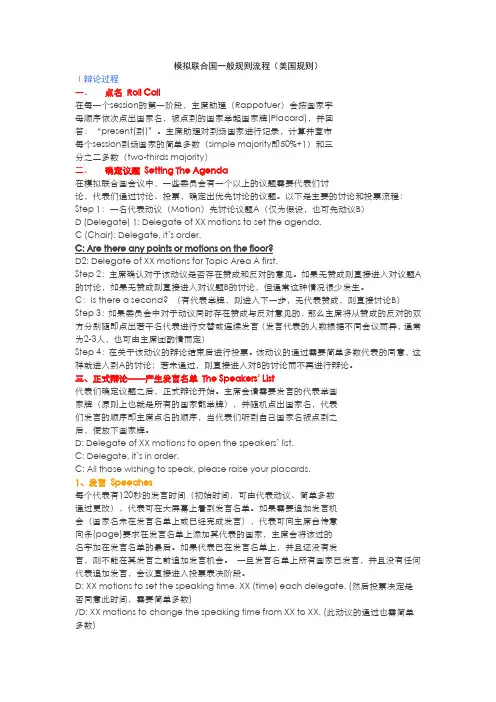
模拟联合国一般规则流程(美国规则)Ⅰ辩论过程一、点名Roll Call在每一个session的第一阶段,主席助理(Rappotuer)会按国家字母顺序依次点出国家名,被点到的国家举起国家牌(Placard),并回答:“present(到)”。
主席助理对到场国家进行记录,计算并宣布每个session到场国家的简单多数(simple majority即50%+1)和三分之二多数(two-thirds majority)二、确定议题Setting The Agenda在模拟联合国会议中,一些委员会有一个以上的议题需要代表们讨论,代表们通过讨论、投票,确定出优先讨论的议题。
以下是主要的讨论和投票流程:Step 1:一名代表动议(Motion)先讨论议题A(仅为假设,也可先动议B)D (Delegate) 1: Delegate of XX motions to set the agenda.C (Chair): Delegate, it’s order.C: Are there any points or motions on the floor?D2: Delegate of XX motions for Topic Area A first.Step 2:主席确认对于该动议是否存在赞成和反对的意见。
如果无赞成则直接进入对议题A 的讨论,如果无赞成则直接进入对议题B的讨论,但通常这种情况很少发生。
C:Is there a second? (有代表举牌,则进入下一步,无代表赞成,则直接讨论B)Step 3:如果委员会中对于动议同时存在赞成与反对意见的,那么主席将从赞成的反对的双方分别随即点出若干名代表进行交替或连续发言(发言代表的人数根据不同会议而异,通常为2-3人,也可由主席团酌情而定)Step 4:在关于该动议的辩论结束后进行投票。
该动议的通过需要简单多数代表的同意,这样就进入到A的讨论;若未通过,则直接进入对B的讨论而不再进行辩论。
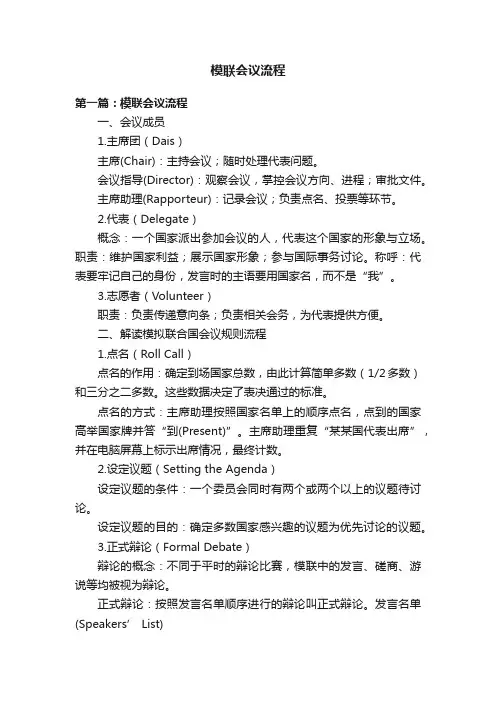
模联会议流程第一篇:模联会议流程一、会议成员1.主席团(Dais)主席(Chair):主持会议;随时处理代表问题。
会议指导(Director):观察会议,掌控会议方向、进程;审批文件。
主席助理(Rapporteur):记录会议;负责点名、投票等环节。
2.代表(Delegate)概念:一个国家派出参加会议的人,代表这个国家的形象与立场。
职责:维护国家利益;展示国家形象;参与国际事务讨论。
称呼:代表要牢记自己的身份,发言时的主语要用国家名,而不是“我”。
3.志愿者(Volunteer)职责:负责传递意向条;负责相关会务,为代表提供方便。
二、解读模拟联合国会议规则流程1.点名(Roll Call)点名的作用:确定到场国家总数,由此计算简单多数(1/2多数)和三分之二多数。
这些数据决定了表决通过的标准。
点名的方式:主席助理按照国家名单上的顺序点名,点到的国家高举国家牌并答“到(Present)”。
主席助理重复“某某国代表出席”,并在电脑屏幕上标示出席情况,最终计数。
2.设定议题(Setting the Agenda)设定议题的条件:一个委员会同时有两个或两个以上的议题待讨论。
设定议题的目的:确定多数国家感兴趣的议题为优先讨论的议题。
3.正式辩论(Formal Debate)辩论的概念:不同于平时的辩论比赛,模联中的发言、磋商、游说等均被视为辩论。
正式辩论:按照发言名单顺序进行的辩论叫正式辩论。
发言名单(Speakers’ List)发言名单的产生:确定议题后,正式辩论开始。
主席会请需要发言的代表举国家牌,并随机点出国家名,当代表听到自己国家被点到后,放下国家牌。
主席助理同步记录,代表便可在大屏幕上看到发言名单。
发言名单的作用:供各国代表根据自己既定的发言主题发表讲话。
发言名单的缺点:各讲各的,主题分散,不利于促进共识的形成。
追加发言机会(国家名未在发言名单上或已经完成发言),可向主席台传意向条(Page)要求在发言名单上添加其代表国家,主席会将该国家名加在发言名单最后。
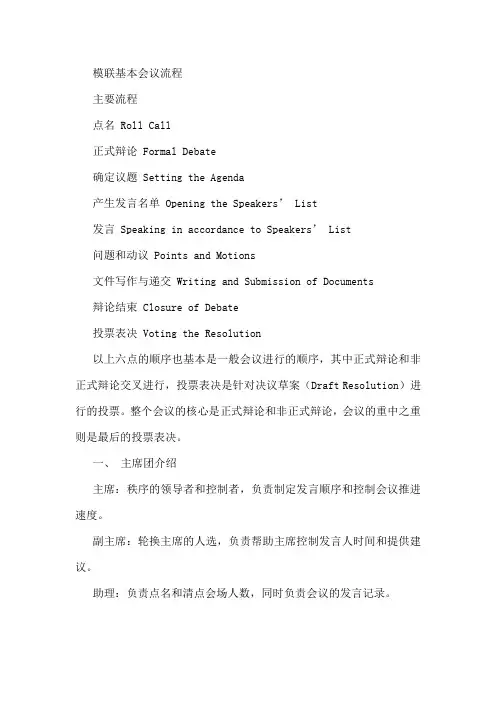
模联基本会议流程主要流程点名 Roll Call正式辩论 Formal Debate确定议题 Setting the Agenda产生发言名单 Opening the Speakers’ List发言 Speaking in accordance to Speakers’ List问题和动议 Points and Motions文件写作与递交 Writing and Submission of Documents辩论结束 Closure of Debate投票表决 Voting the Resolution以上六点的顺序也基本是一般会议进行的顺序,其中正式辩论和非正式辩论交叉进行,投票表决是针对决议草案(Draft Resolution)进行的投票。
整个会议的核心是正式辩论和非正式辩论,会议的重中之重则是最后的投票表决。
一、主席团介绍主席:秩序的领导者和控制者,负责制定发言顺序和控制会议推进速度。
副主席:轮换主席的人选,负责帮助主席控制发言人时间和提供建议。
助理:负责点名和清点会场人数,同时负责会议的发言记录。
会议指导:负责所有文件的审阅和核批,同时对于会场中的规则性问题具有最高解释权。
二、点名 Roll Call为了了解会场国家出席情况和确定简单多数和2/3多数,各会场需要在大会开始前以及每次中断后重新开始前和投票前都进行点名。
当会议助理按照字母顺序报出国家名时,代表需要举牌示意并回答“到(present)”。
最后一个国家示意完毕后助理会宣布出席国家数、简单多数(过半数)和绝对多数(过2/3),此部分即告结束。
三、确定议题 Setting the Agenda当会场中存在两个或更多议题时,主席随机点出支持讨论各议题的代表各3名,按不同议题支持者各一的次序进行轮换陈述。
每位代表各自陈述时间90秒,阐述选择先讨论议题的原因、动机等。
随即主席要求全场各位代表投票决定议题,当某一议题简单多数通过时,此部分即告结束。
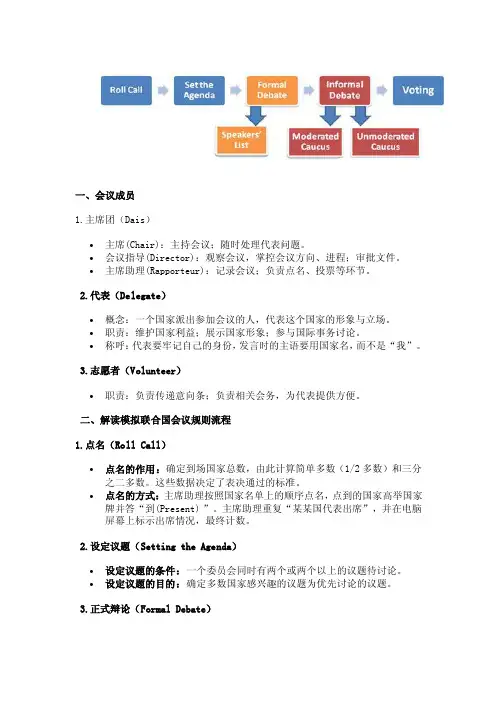
一、会议成员1.主席团(Dais)∙主席(Chair):主持会议;随时处理代表问题。
∙会议指导(Director):观察会议,掌控会议方向、进程;审批文件。
∙主席助理(Rapporteur):记录会议;负责点名、投票等环节。
2.代表(Delegate)∙概念:一个国家派出参加会议的人,代表这个国家的形象与立场。
∙职责:维护国家利益;展示国家形象;参与国际事务讨论。
∙称呼:代表要牢记自己的身份,发言时的主语要用国家名,而不是“我”。
3.志愿者(Volunteer)∙职责:负责传递意向条;负责相关会务,为代表提供方便。
二、解读模拟联合国会议规则流程1.点名(Roll Call)∙点名的作用:确定到场国家总数,由此计算简单多数(1/2多数)和三分之二多数。
这些数据决定了表决通过的标准。
∙点名的方式:主席助理按照国家名单上的顺序点名,点到的国家高举国家牌并答“到(Present) ”。
主席助理重复“某某国代表出席”,并在电脑屏幕上标示出席情况,最终计数。
2.设定议题(Setting the Agenda)∙设定议题的条件:一个委员会同时有两个或两个以上的议题待讨论。
∙设定议题的目的:确定多数国家感兴趣的议题为优先讨论的议题。
3.正式辩论(Formal Debate)∙辩论的概念:不同于平时的辩论比赛,模联中的发言、磋商、游说等均被视为辩论。
∙正式辩论:按照发言名单顺序进行的辩论叫正式辩论。
∙发言名单(Speakers’ List)∙发言名单的产生:确定议题后,正式辩论开始。
主席会请需要发言的代表举国家牌,并随机点出国家名,当代表听到自己国家被点到后,放下国家牌。
主席助理同步记录,代表便可在大屏幕上看到发言名单。
∙发言名单的作用:供各国代表根据自己既定的发言主题发表讲话。
∙发言名单的缺点:各讲各的,主题分散,不利于促进共识的形成。
∙追加发言机会(国家名未在发言名单上或已经完成发言),可向主席台传意向条(Page)要求在发言名单上添加其代表国家,主席会将该国家名加在发言名单最后。
un4mun规则流程
UN4MUN (United Nations for Model United Nations)是一种国联模
拟会议,以下为其一般规则流程:
1.分配国家和委员会:组织方负责分配各个参与者的国家和所在委员会,确保每个国家都有代表参与模拟会议。
2.研究指导文件和国家立场:参与者应该仔细研究委员会指导文件和
所代表国家的立场,包括该国的政治、经济和社会情况,以及该国在所讨
论议题中的立场和利益。
3.会议前文件撰写:代表们需要准备并提交自己的立场文件,包括建议、决议和发言稿。
4.会议正式开始:会议正式开始后,主席会根据议程安排并开始会议。
5.发言:代表们可以按照议程逐一发言,陈述自己的立场和观点,并
尝试说服其他代表支持自己的立场。
6.辩论:代表们可以互相应对,并对其他代表提出的意见和观点发表
自己的意见和观点。
7.决议草案和讨论:代表们可以合作起草决议草案,并就其中的问题
进行讨论和协商。
8.投票:最后,主席将通过投票方式决定是否通过最终决议草案。
9.闭幕:会议正式闭幕,并发表闭幕讲话。
模联流程以及基本用语Model United Nations (MUN) is a simulation of the United Nations where students take on the roles of representatives from various countries. Through MUN, students have the opportunity to learn about international relations, diplomacy, and the functioning of the United Nations. In the beginning, delegates are assigned a countryto represent and are tasked with researching the foreign policy of that country. They then participate in debates, negotiate with other delegates, and draft resolutions to address global issues.模拟联合国(MUN)是一个模拟联合国的活动,学生扮演各国代表的角色。
通过MUN,学生有机会了解国际关系、外交以及联合国的运作方式。
一开始,代表们会被分配一个国家来代表,并被要求研究该国的外交政策。
然后他们参与辩论,与其他代表协商,并起草决议以解决全球问题。
One of the key aspects of the MUN process is the use of parliamentary procedure, which is a set of rules and practices used to conduct meetings and make decisions. Parliamentary procedure helps ensure that debates are conducted in an orderly and efficient manner, with delegates following established protocols for speaking,making motions, and voting on resolutions. Understanding parliamentary procedure is essential for delegates to effectively participate in MUN conferences and contribute to the dialogue.MUN conferences are typically organized by schools, universities, or non-profit organizations and bring together students from diverse backgrounds and cultures. These conferences provide a platform for students to engage in discussions on a wide range of global issues, such as climate change, human rights, and international security. By participating in MUN conferences, students develop critical thinking, public speaking, and negotiation skills, as well as gain a better understanding of complex international issues.In addition to participating in MUN conferences, delegates can also engage in Model UN clubs at their schools or universities. These clubs offer opportunities for students to practice their MUN skills, engage in debates, and prepare for upcoming conferences. Model UN clubs often host practice simulations, workshops, and guest speakers to help students improve their understanding of global affairs and enhance their diplomatic skills. Joining a Model UN club can provide delegates with a supportive community of like-mindedindividuals who share a passion for international relations and diplomacy.One of the challenges delegates may face during MUN conferences is balancing their national interests with the need for cooperation and compromise. Delegates must represent the foreign policy of their assigned country accurately while also working towards consensus on resolutions with other delegates. This requires delegates to navigate complex geopolitical dynamics, build alliances, and find common ground with countries that may have opposing viewpoints. Developing the ability to negotiate diplomatically and advocate for their country's interests effectively is a crucial skill for delegates to master in MUN.Overall, participating in Model United Nations offers students a unique and enriching experience that allows them to deepen their understanding of global issues and develop valuable skills for the future. By engaging in debates, negotiations, and collaborations with peers from around the world, delegates hone their critical thinking, communication, and leadership abilities. Model UN not only prepares students for future careers in international relations, law,and public policy but also fosters a sense of global citizenship and a commitment to solving complex problems through diplomacy and cooperation.参加模拟联合国为学生提供了一次独特而丰富的经验,使他们加深对全球问题的理解,并为未来发展宝贵的技能。
【最新整理,下载后即可编辑】•What is MUN?在模联会议里,参加者(delegates)以代表团(delegation)为单位,共同代表一个国家(to Represent A Certain Country),在模拟联合国会议中的不同委员会(committee)里,以国家代表身份进行演讲(public speaking)、辩论(debate)和游说(lobby)等,争取国家利益的最大化。
代表参与正式辩论(formaldebate)、非正式辩论(informal debate),以及广泛的协商合作(negotiation and collaboration),以争取其所代表国家的国家利益能在特定议题(topic area)的决议(resolution)中得到充分体现。
一个委员会(committee)由一个主席团(members of the dais)负责。
主席(the chair)主持会议,其任务是按照联合国正式的程序规则监督并推动会议进程(oversee debate and guidedelegates through the rules of procedure)。
会议指导(director)负责审阅批准代表提交的会议文件,并对会议进程和代表表现提出建议和评价;主席助理(rapporteur)负责点名、统计代表数、录入发言人名单(speakers’ list)。
常见委员会有:联合国大会(General Assembly-GA)、经济与社会理事会(Economic and Social Council-ECOSOC)、安全理事会(Security Council-SC)等。
用联合国的方式解决问题:相对的公平(Relatively Equal): Equal to be heard; Equal to draft;Equal to vote有效的推动(Push forward to a result): A resolution, if not thebest, is maybe the best possible way to solve the issue. If failed,the next could still be possible.What can we benefit from MUN?1、演讲public speaking2、合作与协商cooperation & negotiation3、获取国际事务的知识knowledge of international affaires4、包容、理解的全面视角perspective5、英语的能力English ability6、组织协调organization & coordinationHow does MUN conference conduct?模拟联合国会议通过严格按照联合国会议的规则(formal rules of procedure)进行,以保证每位代表都有平等的发言权(equal opportunity to be heard)。
大会规则流程(Rules of Procedures)1点名(Roll Call)主席按照首字母顺序点国家名时,代表需举国家牌(Playcard)并答“到(Present)!”。
e.g:Chair: Distinguished delegates, now we’re going to have the roll call. Please raise you placard and answer ‘present!’” China:“Present!”例:主席助理:“尊敬的各位代表,现在我们开始点名。
请被点到的代表举起国家牌并答‘到’。
中国。
”中国代表:“到。
”点名完毕后,主席助理公布实到代表数,以及简单多数——与会国家代表的50%+1(Simple Majority)和三分之二多数——与会国家代表的2/3(Two-thirds Majority)。
例:主席助理:“与会代表共30人,则简单多数为16人,三分之二多数为20人。
”之后,大会进入下一议程——设定议题。
2设定议程(Setting of Agenda)当委员会的议题超过1个时,与会代表必须表决,决定首先讨论的议题。
A.由某国动议先讨论议题A(或B)B.由主席在所有欲发言的国家中随机点出赞成首先讨论议题A和赞成首先讨论议题B的各3个国家代表,陈述为何首先讨论该议题。
双方轮流发言(A1-B1-A2-B2-A3-B3),各90秒。
C.待6国代表发言完毕后。
由某国动议结束讨论(close the debate)。
D.主席请两个反对结束讨论的代表发言。
E.大会就结束讨论的动议进行投票,三分之二多数通过。
F.如果结束讨论的动议获得通过,大会就是否先讨论议题A(或B)进行投票,简单多数通过。
例:主席:“既然我们有两个议题,现在我们开始确定首先讨论的议题。
想要首先讨论议题A的代表请举牌。
美国,墨西哥,蒙古,谢谢。
想先讨论议题B的代表请举牌。
匈牙利,斯里兰卡,白俄罗斯,谢谢。